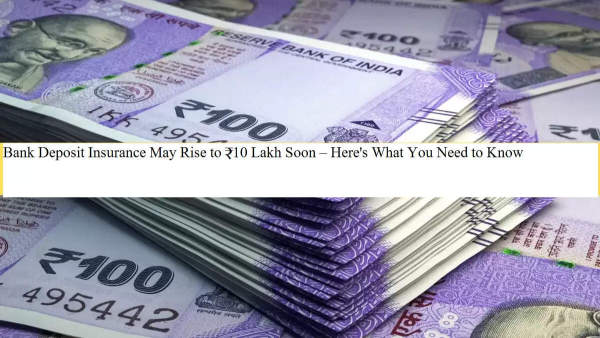
To enhance depositor protection, the Indian government is considering doubling the bank deposit insurance limit from ₹5 lakh to ₹10 lakh. Here's when this change could happen and how it may impact your money.
Bank Deposit Insurance Limit Set to Increase: A Big Relief for Depositors
In a major move to strengthen financial security for depositors, the Indian government is reportedly planning to increase the bank deposit insurance limit from ₹5 lakh to ₹10 lakh. This change, if implemented, would provide greater assurance to account holders in case a bank faces financial trouble or collapses.
Currently, under the Deposit Insurance and Credit Guarantee Corporation (DICGC), bank deposits up to ₹5 lakh are insured. This means if a bank fails, depositors are eligible to receive compensation up to this amount. However, any funds beyond ₹5 lakh are not covered, leading to concerns among customers with higher deposits.
Why This Change Matters
The deposit insurance limit was last revised in 2020 following the Punjab and Maharashtra Cooperative (PMC) Bank crisis, which left thousands of depositors anxious about their savings. Before that, the limit had remained unchanged at ₹1 lakh since 1993. A significant portion of depositors welcomed the move to ₹5 lakh, but as inflation and average savings amounts have increased, experts and industry insiders have long called for another revision.
According to a report by Business Standard, the finance ministry may increase the insurance limit to ₹10 lakh within the next six months. While no official notification has been issued yet, signals from government sources suggest that deliberations are underway.
How Much of Your Deposit Is Safe?
As per data from the DICGC as of March 31, 2024:
Out of 2.89 billion total bank accounts, around 98% are fully insured under the existing ₹5 lakh limit.
However, when considering the total value of all bank deposits, only 43.1% of the total deposit amount is covered by the insurance scheme.
This means that while most account holders are protected in terms of number of accounts, a significant chunk of money in the banking system remains uninsured—particularly for those with large savings or business-related accounts.
The Numbers Behind Deposit Insurance
The DICGC, a wholly-owned subsidiary of the Reserve Bank of India (RBI), maintains a Deposit Insurance Fund to cover claims. Here's a look at some key figures from the 2023-24 fiscal year:
The total size of the insurance fund stood at ₹1.98 lakh crore.
Claims amounting to ₹1,432 crore were settled, primarily from cooperative banks.
DICGC earned ₹23,879 crore from insurance premiums collected from banks.
A total of 1,997 banks are currently registered with the DICGC, including 140 commercial banks and 1,857 cooperative banks.
A Brief History of Deposit Insurance Limits in India
Deposit insurance in India was introduced in 1962, with an initial coverage of just ₹1,500. Over the decades, the limit has gradually increased in response to changing financial conditions:
1976: Raised to ₹20,000
1980: Increased to ₹30,000
1993: Moved up to ₹1 lakh
2020: Doubled to ₹5 lakh
If the proposed change goes through, it would mark another significant step in boosting depositor confidence and aligning India’s financial protection framework with global standards.
Final Thoughts
With increasing uncertainty in the financial sector and the rising value of individual savings, enhancing deposit insurance to ₹10 lakh would be a welcome move for millions of Indians. While most small depositors are already fully covered, the revision would extend a crucial safety net to medium-sized depositors and senior citizens who often keep larger sums in fixed deposits.
All eyes are now on the government to see when this policy will officially roll out. Until then, depositors are advised to stay informed and diversify their funds if necessary to stay within insured limits.
Contact to : xlf550402@gmail.com
Copyright © boyuanhulian 2020 - 2023. All Right Reserved.